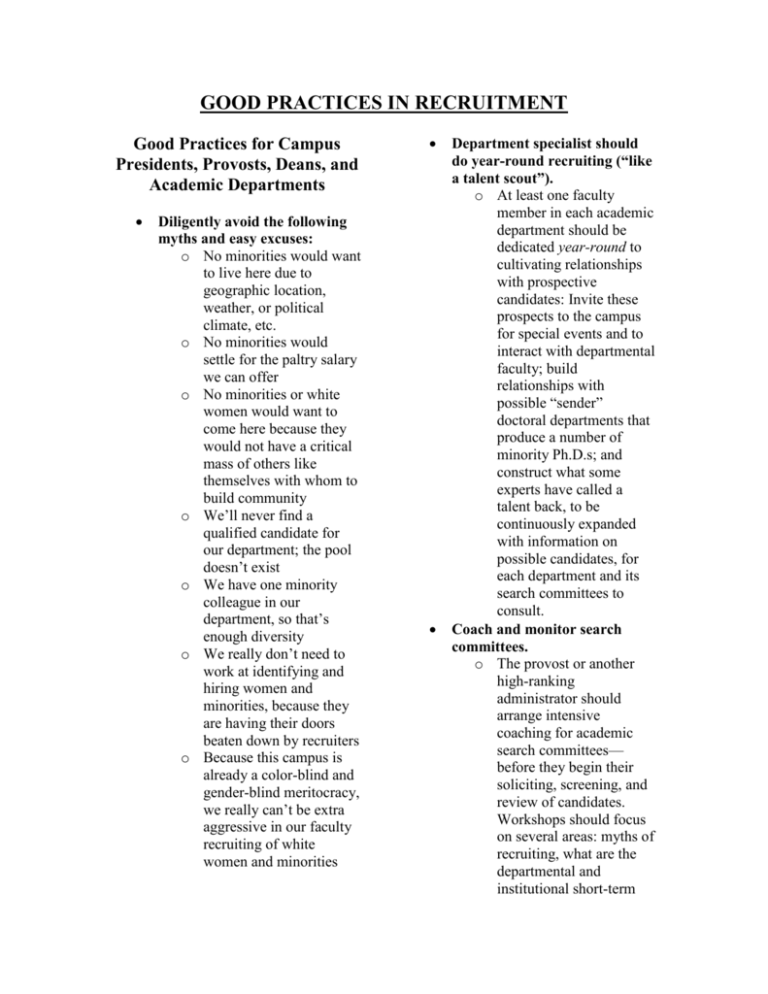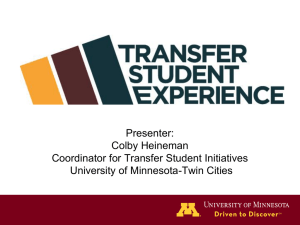Best Practices in Recruitment, Retention, and Mentoring by
advertisement

GOOD PRACTICES IN RECRUITMENT Good Practices for Campus Presidents, Provosts, Deans, and Academic Departments Diligently avoid the following myths and easy excuses: o No minorities would want to live here due to geographic location, weather, or political climate, etc. o No minorities would settle for the paltry salary we can offer o No minorities or white women would want to come here because they would not have a critical mass of others like themselves with whom to build community o We’ll never find a qualified candidate for our department; the pool doesn’t exist o We have one minority colleague in our department, so that’s enough diversity o We really don’t need to work at identifying and hiring women and minorities, because they are having their doors beaten down by recruiters o Because this campus is already a color-blind and gender-blind meritocracy, we really can’t be extra aggressive in our faculty recruiting of white women and minorities Department specialist should do year-round recruiting (“like a talent scout”). o At least one faculty member in each academic department should be dedicated year-round to cultivating relationships with prospective candidates: Invite these prospects to the campus for special events and to interact with departmental faculty; build relationships with possible “sender” doctoral departments that produce a number of minority Ph.D.s; and construct what some experts have called a talent back, to be continuously expanded with information on possible candidates, for each department and its search committees to consult. Coach and monitor search committees. o The provost or another high-ranking administrator should arrange intensive coaching for academic search committees— before they begin their soliciting, screening, and review of candidates. Workshops should focus on several areas: myths of recruiting, what are the departmental and institutional short-term and long-term needs, recognizing and correcting sloppy thinking, recognizing and moving beyond gender and racial mind-sets, and understanding how colonized minorities in the U.S. society are often treated as if they are indelibly marked at birth by intellectual and moral inferiority. An academic department should construct its retention plan for new faculty hires even before recruitment begins. o Seeing a well-crafted and approved retention plan in place reassures job candidates that their wellbeing, success, and professional growth do matter. Diversify within each search committee. Add a diversity advocate within each committee. o Make sure that every committee itself is diverse and has at least one woman and one minority faculty member; also consider including on every search committee a senior faculty member from outside the hiring department whose role is to serve as an advocate for diversity. Language in job ads should underscore the desire for diversity. o Also make sure that your campus’s mission clearly states that the institution values cultural diversity within its student body and faculty ranks and subscribes to the educational value of diversity. Make sure departments and divisions are offering equitable salary and benefit packages to new hires. o The provost and president should set the expectation that, within each department, the salary and equipment packages for new hires will be very similar; data on these packages should be monitored. Constantly monitor the recruiting and hiring processes and outcomes in all departments—to make the system more transparent. o Top administrators should have their appropriate representatives undertake exit interviews with those hired and not hired, to discover the strengths, weaknesses, and possible inequities of the hiring process. Have the chair and dean do the final choosing and hiring of candidates. o The committee recommends but does not take the final step, which calls for the provost or dean to be an active member of each search committee. Hold deans and chairs accountable for faculty diversity. o Such accountability would keep these key leaders centrally involved in the work of their departments’ hiring committees. Provide sufficient financial resources and staff support for diversifying the faculty. o The president’s and provost’s offices will need to provide funding to underwrite some or all of the following: Extra staff support for search committees, “target of opportunity” incentives and “bridge” grants to help those departments that are prepared to hire non-majorities, release time for one faculty member in each department who is dedicated to year-round recruiting, incentive or supplemental grants to enable divisions and departments to do cluster hiring, and support of a greater number of minority speakers on campus. Assist with spousal job hunting. o If the candidate can be sure that his or her partner will have meaningful employment (either at your campus or somewhere nearby), your likelihood of securing that candidate as a faculty member is considerably enhanced. Pay attention to the lifestyle concerns of job candidates. o Lifestyle issues are at the top of candidates’ lists; however departments have been slow to appreciate this fact. Each hiring committee should initiate discussions of lifestyle concerns that candidate may have. Provide housing assistance to new hires. o Assisting with housing can insure that at least some of their minority or majority faculty and their families live in inclusive, multicultural residential areas. Also hire senior faculty members. o Besides hiring pre-tenure women and minorities, campuses and departments should recruit tenured faculty who already have positions at other universities. Bring to campus visiting scholars from underrepresented groups. o Visiting or adjunct minority professors will enrich the intellectual enterprise for students and faculty and probably attract additional underrepresented faculty and students to the campus. Include non-majority speakers in every lecture and seminar series. o In departmental and campus lecture series and intellectual forums, make sure that a sizable (not a token) number of U.S. minorities and women are featured. Reduction of novelty will be hastened by the presence of these speakers. Start a visiting dissertation scholars-in-residence program on campus. o This may result in the host departments hiring the scholars as assistant professors. Guidelines for Search Committees Avoid easy excuses and selffulfilling myths about how difficult it will be to hire minority and women faculty. Recruit year-round “like a football coach” Receive coaching from the provost. Ensure diversity in the committee’s membership. Use detailed language about faculty diversity in the job advertisement, not merely boilerplate statements. Follow key pointers for campus visits and interviews of job candidates. Send an unranked list of final candidates to the dean and department chair, for either their input or their decision. Throughout the search committee’s work, its members should avoid sloppy, biased thinking and decision-making (bad practices). GOOD PRACTICES IN RETENTION Good Practices for Key Campus Leaders and Mentoring Programs Implement a formal campuswide mentoring program. o The offices of the provost and/or dean of the faculty assign a two- or threeperson mentoring committee to each faculty newcomer, whether minority or majority. They meet every three months or so to discuss current situation and problems that need to be resolved. Sponsor career-development workshops for faculty throughout the year. o The office of the provost or dean of the faculty should sponsor such workshops for new and established faculty. Topics of perennial interest include: writing proposals to secure research and travel support, improving your research, getting your work published, etc. Provide child-care facilities on campus. o Providing this service on campus would eliminate one major stressor. Allow family leave. o Slowing down the tenure clock, for both male and female faculty involved in child rearing, is desperately needed. Provosts and presidents must check to see that there are no penalties for faculty who make use of such family leaves. Ensure leadership positions for non-majority faculty. o All campuses must seek ways to move nonmajorities into leadership posts that have been forbidden to them in the past. Hold critical thinking workshops for department chairs, senior faculty, and tenure and promotion committees on a regular basis. o Because annual jobperformance assessments and tenure decisions regarding non-majority faculty are likely to be unconsciously corrupted by gender and racial/ethnic schema often held by majority powerholders, strategies must be followed to overcome this corruption. Provide mentoring training for department chairs, senior faculty, and new associate professors. o Special sessions for department chairs and senior faculty should enable them to become more effective monitors and mentors of pre-tenure faculty. Reward senior faculty for their attentive mentoring of new faculty. o The rewards could take the form of a course release, extra professional travel money, new lab equipment, a supplemental stipend, and so on. For faculty new comers, arrange campus-wide orientation sessions and cordial visits with the dean. o Campus-wide orientation sessions, mandatory for all new faculty, should begin prior to newcomers’ first semester and occur every two months thereafter for the entire first year. Sponsor community-building events for new hires and pretenure faculty. o Include not only the campus’s junior faculty, but also junior faculty from other campuses in the state or region. Such a community-building event is especially critical for minorities, who will appreciate meeting other who are in similar token situations on majority colleges and universities. Bring in speakers chosen by junior faculty. o As a result of this innovative speakers series, the department and campus are enriched; the pre-tenure faculty add the visitors to their own professional network; and the senior visitors—rather than the pre-tenure faculty—bear much of the intellectual weight of introducing and explain unconventional or controversial approaches. Develop a campus culture that is working to level the academic playing field, value multicultural diversity, and build community. Encourage and develop senior faculty who serve as champions for diversity. o Provosts and deans should identify senior majority faculty in various disciplines who are attempting to be “bridge leaders” and advocates for diversifying the student body and faculty ranks. Good Practices for Academic Departments Prepare members of the department for the new hire’s arrival. Supply newcomers with essential information about departmental operations months before their arrival on campus. Introduce and warmly promote the new faculty member to students at the beginning of the semester, as well as to other faculty colleagues. Senior faculty in the department must become persistently friendly and instrumentally helpful to newcomers, especially minority ones. The department chair and senior faculty should protect junior faculty, in particular minorities, from excessive teaching, advising, and service assignments. Actively work to help new faculty make scholarly connections within and outside the department. The department chair and senior faculty (making up a review committee) should assess and monitor pre-tenure faculty as they work to meet the tenure requirements for teaching, research and service. Assign senior faculty the responsibility for actively mentoring newcomers GOOD PRACTICES IN MENTORING Good Practices for Senior Mentors Recognize the hesitation for some mentees and try to move beyond it. o Some minority and women faculty many not feel entitled to the attention and protection of senior mentors, so mentors should take the lead. Disclose some of your own failures and confusions. o As a mentor, you should disclose to your mentee, fairly soon in the mentoring relationship, some failures and confusion that you yourself have experienced; if you do not disclose some of these low points, junior faculty will probably put you on a pedestal. Address critical incidents experienced by mentees—and assist with damage control. o No later than the first week of the mentoring relationship, the mentor should be light-handedly insistent that mentees discuss hurtful or confusing critical incidents they may be experiencing as try execute their various duties as anew professor and interact with students and colleagues. Understand the typical cumulative disadvantages for those viewed as “outsiders” and “tokens.” o The mentor should be alert to and empathetic with any undervaluing and chilliness that may be experienced by the mentee. Understand the extra disadvantages for members of colonized minority groups. o Colonized minorities in this country include Puerto Rican Americans, Mexican Americans, African Americans, American Indians, Native Hawaiians, and Native Alaskans. Having been reared in the United States, members of these minority groups probably have had to deal with a steady barrage of belittling comments and attitudes about their intellectual abilities. Help mentees learn how to selfpromote. o For introverts, a mentor can suggest behind-thescenes ways to ensure that one’s work gets its due. Undertake instrumental, proactive mentoring. o Mentors need to provide psychological bolstering and also careeradvancement interventions. Mentees should receive inside information about the real workings of academic departments; what the unspoken rules are; how one methodically builds a track record of achievement by leveraging a new success from a previous one; and how one methodically expands a professional support network. Observe some ground rules when arguing with mentees. o If disagreements become intense, make sure you consciously shift gears and start sentences with “I” rather than “you.” Rise above gender and racial/ethnic stereotypes. o Be mindful of gender and racial schemas and stereotypes you may have internalized from having lived in this society. Avoid the temptation to clone. o Be careful not to impose your own career path on the mentee. Realize that you are providing invaluable guidance and collegial support. o Mentors can make a tremendous difference in showing junior colleagues the ropes, reducing their loneliness and bewilderment, applauding their strengths, and shoring up their weaknesses. Pointers and Strategies for PreTenure Faculty Members (Typical Stressors—and What to do About Them) Lack of collegiality o New faculty who thrive and succeed typically spend about five hours per week networking and building collegiality through face-to-face visits, letters, hone calls and email with colleagues near and far. Negativity o Successful new faculty take an optimistic approach to their students, their colleagues, and their campus. For example, avoiding people who gossip. Unrealistic expectations o Listen to “self talk” first of all to see how you are treating yourself and whether or not you are giving yourself credit for what you’ve already accomplished. Not enough time o Talk in concrete ways to other junior faculty and to senior faculty inside and outside your department, both about how to teach more efficiently and effectively and about the organization of your scholarly projects. Lack of experience in teaching: Lessons from quick starters o Become student friendly, regard your teaching as somewhat public and continuously improving, take your time in the classroom, experiment with a rage of discussion techniques. Obstacles to writing and networking o Make time to do scholarship, write in brief, non-fatiguing, daily sessions, learn the tricks of the trade regarding publishing, network, get something down on paper, set milestones, and don’t be terribly hard on yourself. Inadequate feedback o Cultivate mentors inside and outside your department who you can take the initiative to seek feedback from, develop a five-year plan for you career, request formal feedback about your job performance, keep careful records, and also file documents that indicate your competency as a teacher. Balancing work and life outside work o Ask admirable people how they are managing to balance their public and private worlds, pay close attention to how you organize your workweek, divide your day into segments, and complete important tasks, not just urgent ones. Coping with the Special Stressors Faced by NonMajority Faculty The extra taxes borne by faculty from colonized minority groups Internalizing feelings of inadequacy Being seen as an “affirmative action hire” Finding a chilly climate within the department Being given too little or too much attention Having your scholarship undervalued Experiencing the acute sting of negative incidents Managing excessive committee assignments Managing excessive student demands Handling inappropriate behavior Overcoming isolation Not feeling entitled to be in academia OTHER REMEDIES: MACROCOSMIC AND MICROSCOPIC Structural and Institutional Changes: Dismantle Castelike Elements; Continue to Act Affirmatively; and Pay Reparations A macrocosmic perspective holds that the economic caste system currently entrapping many colonized minorities must be dismantled, the low job ceiling lifted, and job segregation ended. “Americans’ best chance for a future that we want our children to inherit is to insist that the practice of the American dream be made to live up to its ideology.” Economic transformation for African Americans, as well as, the government and American corporations should pay reparations to African Americans. Forming antiracism organizations that will take over and cover actions to dismantle white racism—is already under way. A call for a new constitutional convention to forge a U.S. constitution of broader vision. Affirmative action in employment. To break through job ceilings, women and colonized minorities in midlevel jobs must receive career-enhancing mentoring; opportunities to develop into visible and influential players; and of course, long-term institutional commitment to remove job ceilings and make room for— and welcome—minorities and women at the top. Power-holders must learn how to make their evaluations of people less subjective and biased; good intentions are insufficient. Create More Diverse Student Bodies and Faculties National studies have demonstrated that substantial educational benefits flow to students of all backgrounds when academic institutions have a diverse student body and faculty. Educators at the institutions must “send an unequivocal message to all their students that the mainstream society encompasses multiple cultures and that all students have much to gain through contact with students of diverse backgrounds”. Predominantly majority institutions should recruit and retain a critical mass of colonized minority students and minority faculty, so that these minorities are not coping with the “solo” phenomenon. Colleges and universities should deemphasize or eliminate the use of standardized test such as the SAT and GRE. Not only are these tests invalid, but they also have a pernicious effect on many students’ self-confidence and ambitions, especially highly motivated, stigmatized minority students their and their families’ ethic backgrounds—so that they come to realize that they are not part of a vague and disembodied norm but rather citizens possessing their own cultural contexts and histories. Create Learning Communities in Colleges and Universities University and college students Educate Students About Unearned Advantages and Disadvantages Faculty and other leaders should help students, from majority and minority groups, better understand the psychological dynamics faced by immigrant and especially colonized minorities. Educators should also encourage majority students to explore and better understand should be able to enroll in several small classes each year where they can develop rigorous critical-thinking skills and participate in collaborative-learning communities with a mix of minority and majority students. The campus community should be reorganized so that the lives and cultures of all students are celebrated and affirmed throughout the intellectual life of the institution. Faculty and administrators would be wise to help majority students understand the value of collaborative and smallgroup learning with those culturally different from themselves—and teach all students communication and conflict-resolution skills that will enable them to maximize the benefits of small-group learning. Tutoring and other academic and psychological support should be available for all students on campus. Educators should be aware that the “model-minority” stereotype can reduce the options of Asian-American students by channeling them into technical fields and away from all others. Create K-12 Learning Communities In elementary and high schools, learning communities must also become the rule. To use high-stakes tests on elementary and high school youngsters is an awful practice. Educators must stop “tracking” (segregating) stigmatized minorities into intellectually stultifying and slow classes in junior high and high schools. Minority students need mentors outside the school system, and these mentors can be found in college and university student organizations, nearby corporations, religious institutions, sororities and fraternities, and so on. Classroom teachers should manifest their belief that all their students possess good prospects. Educators and community leaders should encourage colonized minority students to accommodate but not assimilate to school, just as immigrants typically do.






